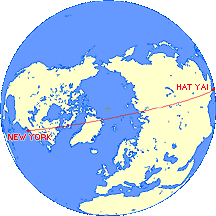Sunday 13 June, 2010, 11:43 - Radio Randomness
Posted by Administrator
Most short-wave listeners would probably love to know whether reception conditions are good or not at any given time on any particular band. One way to do this might be to use an on-line tool, such as the one shown on the right, which tries to interpret solar conditions (eg sunspot numbers) to provide an indication of whether specific frequencies are likely to perform well. This is a good start but gives no idea of from which areas signal are being received. Knowing that frequencies below 10 MHz are suject to 'fair' propagation tells you little about whether this is to the East, West, North or some other direction.Posted by Administrator
Another way, therefore, might be to try and tune in to radio broadcasts from specific areas to see what can actually be received. This works pretty well and tools like that provided at short-wave.info can help you find where signals are being transmitted from and thus what else you might be able to hear.
But radio broadcasts are not the only short-wave transmissions which can be regularly received. There are many other signals which can give indications of propagation. Radio amateurs have networks of worldwide beacons. These can be found on frequencies of 14100, 18110, 21150, 24930 and 28200 kHz and each beacon sends its callsign in morse code at a relatively high power (100 Watts) and then decreases the power down to a few milliWatts. Once it is done, another beacon uses the frequency, with the frequencies time shared between them. These beacons (and other amateur beacons which operate) provide an alternative means of testing propagation. Of course if you can't read morse code (CW) then they are of little use. Also, frequencies below 14 MHz are not well served and though 100 Watts is a relatively strong signal for radio amateurs, it is not in the kiloWatt region which radio broadcasters use and thus may be more difficult to hear for the average short wave listener.
At Wireless Waffle it was realised that it would be useful if there were other means of checking propagation which didn't rely on knowing morse code, covered more frequencies, was easy to receive, and would give an idea of in which direction signals were coming from. Step up the the challenge volmets!
 A volmet is a radio broadcast of weather information (meteo in French) for aircraft (vol is French for flight). Volmets exist in many countries around the world and there are several on short-wave which use relatively high power transmissions (normally between 1 and 10 kW) on various frequencies ranging from 2.8 to around 15 MHz. Most frequencies are shared between multiple volmets who take it in turn to broadcast local weather conditions for 5 minutes and then pass the frequency on to the next station (sound familiar?)
A volmet is a radio broadcast of weather information (meteo in French) for aircraft (vol is French for flight). Volmets exist in many countries around the world and there are several on short-wave which use relatively high power transmissions (normally between 1 and 10 kW) on various frequencies ranging from 2.8 to around 15 MHz. Most frequencies are shared between multiple volmets who take it in turn to broadcast local weather conditions for 5 minutes and then pass the frequency on to the next station (sound familiar?) There is a relatively up-to-date list of active, inactive and planned volmets available on-line. One evening recently a receiver was set on 6676 kHz. This is the frequency used by a series of Asian volmets in Australia, India, Thailand, Pakistan and Singapore, each of which uses the frequency for 5 minutes at a time, suprisingly at least three of these were clearly heard (though there was some interference from the Echo Charlie band radio pirates who also use these frequencies!) The following evening on the same frequency, nada, nix, nothing. None of them were audible. An almost perfect example of the use of these stations as propagation beacons.
 An even odder one but of startling usefulness is the frequency of 13270 kHz. This is used by two volmets, one in the USA (New York) and one in Canada (Gander). It is also used for a digital HF radio system for aicraft to report their position when outside of radar coverage called ACARS by a station in Hat Yai in Thailand. Tuning to this frequency recently, both the volmet and the ACARS service could be heard! The New York volmet weather man was churning out temperatures and dew points and the like, whilst over the top came the occasional 'beep fluff' noise of ACARS. It seems a little odd that two aeronautical services would be put on the same frequency but when you consider that Hat Yai is 9190 miles from New York (as the crow flies - though he would get pretty cold whilst going over the north pole) then the probability of interference is probably too small to worry about under normal circumstances. It makes a very handy propagation beacon though - almost around the whole world on one frequency!
An even odder one but of startling usefulness is the frequency of 13270 kHz. This is used by two volmets, one in the USA (New York) and one in Canada (Gander). It is also used for a digital HF radio system for aicraft to report their position when outside of radar coverage called ACARS by a station in Hat Yai in Thailand. Tuning to this frequency recently, both the volmet and the ACARS service could be heard! The New York volmet weather man was churning out temperatures and dew points and the like, whilst over the top came the occasional 'beep fluff' noise of ACARS. It seems a little odd that two aeronautical services would be put on the same frequency but when you consider that Hat Yai is 9190 miles from New York (as the crow flies - though he would get pretty cold whilst going over the north pole) then the probability of interference is probably too small to worry about under normal circumstances. It makes a very handy propagation beacon though - almost around the whole world on one frequency!1 comment
( 2115 views )
| permalink
| 



 ( 3.2 / 36863 )
( 3.2 / 36863 )




 ( 3.2 / 36863 )
( 3.2 / 36863 )

